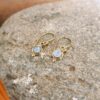
Tourmaline is a magnificent gem with colors as varied as that of a rainbow. Its wide range of colors: black, green, brown, yellow, red, pink, blue, yellow, colorless or multicolored, comes from the different chemical elements that compose it: iron, manganese, nickel, cobalt, titanium… Its name is derived from Sinhala word (language spoken in Sri Lanka) "tournamal" which means "stone with mixed colors". Tourmaline, although present on all continents, is widely imported to Europe, by Dutch sailors bringing it back from the Kingdom of Ceylon.
The majority of tourmaline comes today from Brazil. The other main deposits are located in Afghanistan, India, Madagascar, Sri Lanka, Tanzania, Burma, Russia and Thailand.
lithotherapy
Tourmaline is known for its electrical properties that give it a role in protecting the body against static electricity and radio waves from all kinds of electrical devices. In lithotherapy, tourmaline is known to act as a detoxifying agent. These crystals promote relaxation of the body and mind.
Anecdote
It is believed that the first tourmalines were discovered by the conquistadors in Brazil in the 1500 years. At the time, it was assumed that these green tourmaline were emeralds. It was not until the nineteenth century that scientists realized that these stones actually had their own kind of mineral.
Maintenance of your gemstones
Tourmaline has a hardness of 7. It is a note on 10, 10 being the hardest stone, the diamond. It is a semi-precious stone very ure and resistant to shocks.
To maintain your tourmalines just wash them with clear water. It is a fine stone that does not need to be cleaned. To recharge the tourmaline it is enough to expose it to the light of the sun or the moon.
Fair trade jewelry
Omyoki offers tourmaline jewelry, designed in France and handmade by talented artisans in India, Nepal and Tibetan communities. Original creations, in limited editions, and sometimes in single piece. This video puts in image, this history of know-how and craftsmen.
Each workshop was visited, to check the working conditions, the quality of life and the fair remuneration of the craftsmen. A personal relationship has been established with each artisan, around countless teas and spending hours chatting, as it should be in Asian countries.




